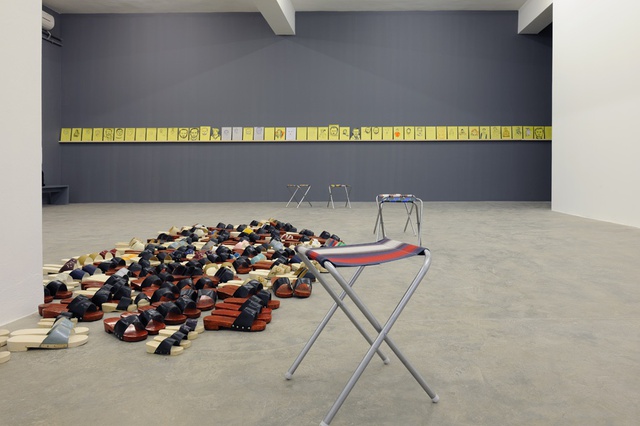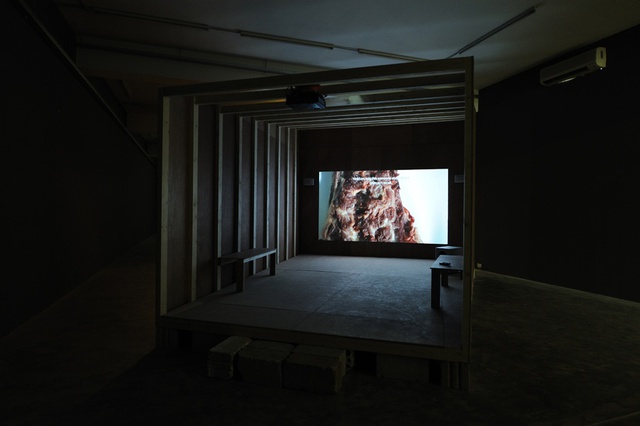Reviews
All Mother Tongues Are Difficult
Mounira Al Solh at Sfeir-Semler Gallery, Beirut
All Mother Tongues Are Difficult (2014) is Mounira Al Solh's second solo show at Sfeir-Semler's Beirut outpost in Karantina, the city's port district, which remains industrial, dirty and off the beaten track in the eyes of local taxi drivers. Living between Beirut and Amsterdam herself, the show is made up of works that play around with ideas of transience, exile and language. Although regular subjects in her work over the years, these themes appear here with particular emphasis on the verbal and the vocal, through works that focus on wordplay, the individual and miscommunication.
Having taken Dutch classes as part of her 'naturalization' process in the Netherlands, the experience of moving between nationalities prompted Al Solh to explore the theme of language in her side project NOA (Not Only Arabic) magazine last year. So far NOA has collaborated with Mona Abu Rayyan, Noa Roei, and Al Solh's partner, writer and current editor of Portal 9 journal Fadi el Tofeili. In future it will be in collaboration with Ghalya Saadawi and Arnisa Zeqo. NOA built on her existing familiarity of living life between languages, having grown up in Beirut, where Arabic, French and English are jumbled together in the city's hybrid dialect. Likewise, her videos, embroidery, painting, drawing and installation work currently at Sfeir-Semler address the loss of sense that occurs when switching out of a mother tongue. It also touches on that space for confusion – potentially comic as well as tragic – that opens up when moving between languages.
The 'mother tongue' of the title sometimes seems to come closer to the notion of a homeland in works representing Syrian displacement. Upon walking in, you are met by a mass of 100 shoes waiting on the floor in the centre of the first room. They are clogs – Damascene and open toed – of many different sizes, including children's. In the same way as she did at Art Dubai this year, Al Solh here invites the gallery-goer to walk in someone else's shoes. Those few visitors who dare to exchange their own footwear for a pair of the clunky, clattering slip-ons that represent Syria's displaced peoples, now numbering 2.6 million globally with 1 million in Lebanon as of April 2014 according to the UN, are physically induced into imagining themselves as the other, envisaging the life-swap that migration entails. The majority of visitors who abstain are taunted by the spectre of so many empty shoes, by the absent bodies they imply, and by their own reluctance to transgress their comfort zone. Typically of Al Solh, the display style of Clogged (2014) is casual and she keeps the ambience light-handed. The absence suggested by empty shoes is always simultaneously absurd and melancholic. These pairs also underscore the parallel Al Solh draws in this show between her own immigration to Holland from Beirut and Syrian immigration to Lebanon, the clog being as associated with Holland as it is with Syria.
Beside the shoes, the ongoing drawings series I strongly believe in our right to be frivolous (2014) run along one wall. A row of portraits, rendered in biro on yellow-lined pages taken from a legal pad, is exhibited unframed: each portrait resembling a cartoonish police mug shot. Resting on a long single shelf, these expressive, detailed sketches each include random details about the person portrayed, all Syrians now living in Lebanon. Their low-tech production and simple presentation avoids any sense of voyeuristic romanticization that might come with portraying refugees, while the personal details hint at broken narratives and the reductive categorizations of legal authorities and the randomization imposed by crossing borders.
Al Solh steps up the discomfort with two films in the next room, the first of these; Vrijouiligers (2012–14) is projected onto a wall and watched from a circle of chairs that echo irritatingly with partially audible voices. Now Eat My Script (2014) is a painfully but wonderfully slow piece full of close-ups, viewed from inside a wooden cube that rests on breezeblocks like a temporary dwelling. The former records the artist's visits to a centre for immigrants in Antwerp, where she learned Dutch as part of her 'naturalization' process in the Netherlands. People from different countries speak in disjointed phrases in the harshly functional setting of a governmental institution, while the audio delivers a frustrating sense of miscommunication and disjuncture, exaggerated by Al Solh's own vocal interjections and questions, dubbed over those filmed.
Quite different to the former, the latter film is amusing, revolting, vulgar, intense and touching all at once. Shots across raw meat pan up at a horrifically protracted pace while Al Solh narrates the story of a sacrificial lamb cooked in honour of a family member in Syria, which makes its way to Lebanon in a picnic fridge in an over-packed family car. The gristle and severed bone is shown in great detail, sometimes delicately, at others seeming grotesque. While revisiting her main theme of transit, Al Solh uses the narrator to ask whether it is possible to process trauma while it is still occurring. Using meat, as many artists have, to provoke visceral disgust in the viewer and to conjure associations with human flesh, the camerawork here prompts a sense of detachment or coping with the mini trauma of the visuals. The most penetrating image from the video is of two eyeballs against a white background as subtitles cross the screen reading, 'murder is murder', in either Arabic or English.
The artist's serious humour continues throughout the remaining two rooms, which are hung with embroideries and paintings whose criticality pivots around wordplay that riffs on language's system of arbitrary signification. Giant patchworked fabrics of brightly coloured curtains are stitched with an Arabic word on the back and front, each using the way that the same sound can represent different meanings: sama'/ma'as meaning 'hearing', 'obeying/crush' or sex; bahr/harb meaning 'sea/war'; toot/toot meaning mulberry or the first month of the year according to the Coptic 'calendar/censorship' or the sound of the car horn as onomatopoeia or the words of a well-known song about Beirut; baa'th/'aabath meaning 'resurrection' and the name of the Baath party in Syria/absurdity; raghb/ghabar meaning 'desire/dust'. The presentation undermines any notion of inherent sense in language. These cloths hang like flags beside paintings of imagined meetings between politicians and great works of art, the best of which has an Iranian politician commenting to a Lebanese one that a Francis Bacon painting looks better online than as an original. Loosely illustrated with sparse caricature-like figures and the occasional hole cut from the canvas, these paintings feel like a departure from the rest of the show, fitting uneasily with the more directly linguistic works even though the canvases also feature Al Solh's signature strokes of role play and absurdity as means to shatter illusions of seriousness and authority.
Despite having previously protested, in her 2007 work Rawane's Song for example, the way the Euro-American dominated art world places expectations of political contextualization and autobiographical reference on artists from the Arab region in her work, Al Solh faces subjects that would satisfy such assumptions in this exhibition. She counterpoints the Syrian refugee experience in Lebanon with her own naturalization process in Holland, and personalizes it through her family's journeying from Beirut to Damascus and back in times of war. She also takes ownership of that liminal place that is the birth right of most Beirutis – between the concise denoted meanings of any single language and occupy a communicative position that is imprecise, contextually dependent, and open to the potential of being understood differently by each individual receiver.
Beirut-born-and-raised émigrée to Germany, Andree Sfeir-Semler, whose eponymous gallery has its original space in Hamburg, told me she exhibits very few of her artists in Beirut, choosing only those whose work she believes will mean something in the context of city. The contextual resonance of the artworks in All Mother Tongues Are Difficult must surely mean something unique in Beirut, their full connotative potential reaching viewers and listeners whose own biographies intersect with Al Solh's reference points first-hand in various ways, producing nuanced receptions. As the war in Syria continues to be felt in Lebanon, Clogged undoubtedly also holds contextual potency on the time axis as well as the place axis. This exhibition deals with exile in real-time, and in the real tones of autobiography that bring life to the informant thematics offered up by geopolitical context.
All Mother Tongues Are Difficult runs from 3 April to 19 July 2014 at Sfeir-Semmler Gallery, Beirut.







